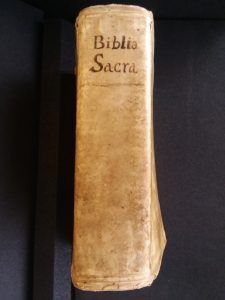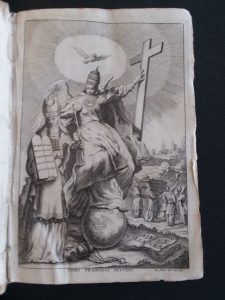Title: Biblia Sacra
Date: 1740
Location: Italy
Publisher: Francis Pitteri
Size: 8 x 5½ x 2½ inches

Front Cover

Book Spine
The Biblia Sacra is a Clementine Vulgate Bible, with “Vulgate” as the Latin word for common. Its title page, bearing the inscription “Biblia Sacra Vulgatae Editionis, Sixti V Pontificis Max. et Clementis VIII Jussu Recognita Auctoritate edita…” in which the authority of this edition of the Vulgate is recognized by Popes Sixtus V and Clement VIII, serves as a hallmark of Clementine Vulgate Bibles. While the Vulgate is still used by the modern Catholic Church, the term “Vulgate” and the version of the Bible it refers to may not be familiar. What is a Vulgate Bible?

Title Page
Vulgate Bibles are Latin translations of this sacred text, first completed by Saint Jerome in the late fourth and early fifth century. The Bible underwent many revisions in both format and appearance, and Vulgate Bibles are no exception. In the sixteenth century, the Protestant Reformation challenged the authority and questioned the validity of the Bible, spurring a series of revisions to the Vulgate undertaken by commissions sanctioned by the papacy.
Over the course of the late sixteenth century, the Catholic Church responded to this issue with a total of four revisions of the Vulgate. These various revisions addressed superficial issues of translation as well as deeper issues regarding actual content of the text. The papacy struggled to make these corrections, as Pope Sixtus V refused the alterations proposed by his commission and instigated his own changes to the Vulgate, which was completed in approximately 1589. However, the need for continued revisions became apparent as the format of Pope Sixtus V’s Vulgate contained translation errors that served as fuel for debates and further questioned the authority of the Latin Bible as the Word of God. Alas, Pope Sixtus V’s vision became the necessity of one of his successors, Pope Clement VIII, under whose papacy the revisions of a fourth commission were accepted and another edition of the Vulgate was released, known as the Clementine edition.
However, even this rendering of the Vulgate is not viewed as without flaw; after its initial publication, it underwent two more revisions in order to remove typographical errors. As such, the history of Vulgate bibles does not end with the release of the Clementine Vulgate in the early seventeenth century, but continues through the twenty-first century. Pope John Paul II approved a new edition of the Vulgate known as the Nova Vulgata, or New Vulgate, which functions as one of the current Latin translations sanctioned by the Catholic Church.
The significance of the Clementine Vulgate stems from its place in historical context; the Protestant Reformation shook the Catholic Church to its core and forced the papacy to evaluate the accuracy and relevancy of its sacred text. The process entailing the rapid revision and release of the various editions of the Vulgate Bible serves as a testament to the attempt made by the church hierarchy not only to address the grievances set against them but also to make their sacred text accessible in a rapidly-changing religious climate. This edition of the Vulgate also marks a prominent milestone in the history of this sacred text. The Clementine Vulgate served as the official version of the Bible as acknowledged by the Catholic Church from the time of its creation in the late sixteenth until the late twentieth century when the Nova Vulgata assumed this role.
The Bible functions as an integral facet of the identity and faith that is Catholicism. Bearing this in mind, the revisions made to the Vulgate, especially those instituted during the sixteenth century, signify a concerted effort to solidify the identity of the Catholic Church using its sacred text as a vehicle.

Print of Saint Peter and Aaron
In this particular edition of the Biblia Sacra, a printed image appears before the biblical text. In this image, two figures appear in the foreground, while a group of four smaller figures are placed in the background. While this print is saturated with symbolism and iconography, focusing solely on the two larger figures in the foreground is illuminating. The figure in the lower left of the page holds two stone tablets and a stick, which most likely serves as writing implement. His headgear, robes, and breastplate mark this figure as a high priest. An open censer lies at his feet. Using this iconography as a guide, it can be deduced that this figure is most likely Aaron, a prominent figure from the Old Testament who was the brother of Moses and the first high priest of the Jewish people.
The larger figure to the right of Aaron is winged and wears long, flowing robes from which one of his feet, resting upon a celestial orb, is visible. The folds of his robes give the impression that he is sitting. This figure bears the three-tiered papal tiara above which a dove hovers, surrounded by light. His left arm is extended outward, with his fingers touching a simple cross. Positioned slightly above Aaron, he gazes down on the high priest as if mentoring him. The iconographic elements surrounding this figure identify him as Saint Peter, one of Christ’s apostles and the first bishop of Rome to whom the popes look back as their predecessor.
The selection of significant figures from both the Old and New Testaments of the Bible is worth further examination as it points to a deeper level of meaning. In his text The Book: A History of the Bible, Christopher De Hamel discusses the various levels of biblical interpretation. One of these levels is allegorical, or typological, in which parallels are drawn between events of the Old and New Testaments.

Back Cover
The typology of the image included in this Clementine Vulgate intertwines the importance of the Old and New Testaments and their publication as a singular, unified pandect. It juxtaposes two figures, one from each of these different sections, and brings them into conversation with one another. This suggests that these texts are in their most powerful and efficacious form when united. In doing so, the Clementine Vulgate reaffirms the quintessential identity of the Catholic Church as being founded upon the Old Testament, yet fulfilled by the New Testament.